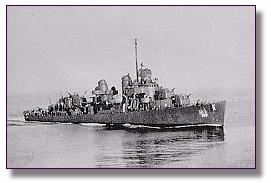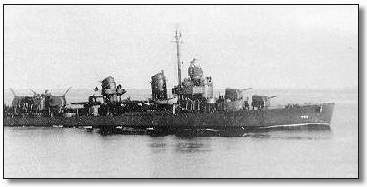First DeHaven DD-469
 After
the completion of her battle-readiness exercises off the coast of New England,
the USS DeHaven (DD-469) departed Norfolk, Virginia, for the South
Pacific on November 8, 1942. Arriving at Guadalcanal on December 7, DeHaven,
was assigned to escort duty and made several voyages between Guadalcanal
and Espiritu Santo, until she was assigned to Task Group 67.5 on January
20, 1943.
After
the completion of her battle-readiness exercises off the coast of New England,
the USS DeHaven (DD-469) departed Norfolk, Virginia, for the South
Pacific on November 8, 1942. Arriving at Guadalcanal on December 7, DeHaven,
was assigned to escort duty and made several voyages between Guadalcanal
and Espiritu Santo, until she was assigned to Task Group 67.5 on January
20, 1943.
On the night of the 24th, DeHaven, in company with two destroyers and two cruisers, arrived off Kolombangara Island to bombard enemy installations on the Villa-Stanmore Plantations. Afterwards, the ships raced out of Kula Gulf and were soon chased by an infuriated enemy, primarily a flock twin-engine bombers. Thanks to a heavily overcast sky, as well as an occasional rain squall, DeHaven's group could not be found, despite the enemy attempt to locate the ships by dropping flares. On February 1, DeHaven, in company with the destroyers O'Bannon (DD-450), Nicholas (DD-449), Radford (DD-446) and a seaplane tender, was escorting six landing craft to establish a beachhead at Morovovo, Guadalcanal. With the assistance of Marine fighters from Henderson Field, the landings were achieved without difficulty However, an enemy scout plane pilot had sighted the activity and notified his base.
After the landing craft disembarked their troops, DeHaven and Nichol were ordered to escort them back to their station, while Radford remained offshore to provide bombardment if necessary. Meanwhile, a dispatch was received warning of an impending air attack.
 At
1445, DeHaven's crew rushed to their battle stations. While lookouts
scanned the skies and the horizon, gun crews were standing by their weapons,
tensely waiting. In the confines of the sweltering engineering spaces, the
heavily perspiring "black gang" checked their machinery, watched water levels
on their boilers and scores of water, air and steam gauges, and stood by
to "answer all bells."
At
1445, DeHaven's crew rushed to their battle stations. While lookouts
scanned the skies and the horizon, gun crews were standing by their weapons,
tensely waiting. In the confines of the sweltering engineering spaces, the
heavily perspiring "black gang" checked their machinery, watched water levels
on their boilers and scores of water, air and steam gauges, and stood by
to "answer all bells."
Throughout other parts of the destroyer, damage control parties closed watertight doors and hatches and nearby, within easy reach, was all the equipment needed to fight fires, flooding and shore up bulkheads; axes, lumber, portable pumps, battle lanterns, fire hoses and more. In the wardroom and after living spaces, Pharmacist's Mates grimly stood by for casualties that were expected to be certain to arrive. All that could be done was accomplished within a few moments. Now DeHaven and her crew were ready.
At about 1457, a swarm of 14 aircraft was sighted off DeHaven's starboard beam at a distance of 25,000 yards. At first, it appeared as though the enemy had not seen the tiny convoy and, for a time, the aircraft remained on their original course. Then, suddenly, six aircraft broke away from the formation and streaked toward the destroyers and their charges.
DeHaven's guns, as well as Nicholas' and those on the landing craft, opened up. Fiery tracers stabbed into the oncoming flock, with bursts of flak blossoming about the planes. Three of the aircraft were sent spiraling in flames into the sea. The remaining three bolted through the heavy mantle of flak and AA fire and, for some reason, singled out DeHaven as their choice target.
 Four
bombs plunged down upon the destroyer, one of which struck the bridge, killing
and wounding all personnel within the structure. Lying dead among the ruins
was her captain, Commander Charles E. Tolman. Two bombs smashed on her bow
and another exploded below her waterline, splitting open her hull plating.
Four
bombs plunged down upon the destroyer, one of which struck the bridge, killing
and wounding all personnel within the structure. Lying dead among the ruins
was her captain, Commander Charles E. Tolman. Two bombs smashed on her bow
and another exploded below her waterline, splitting open her hull plating.
Severely crippled, DeHaven lost all power, came to a halt and began to settle swiftly by the bow. Five minutes after the last bomb had hit, the destroyer's bow was well under, her stern high out of the water. Ensign C.L. Williams, the only officer who was not wounded, realized that DeHaven was going down and passed the word to abandon ship. While the personnel below decks were scrambling to escape from out of the topsy-turvy hell in the lower compartments, DeHaven suddenly upended and plunged to her watery grave, taking 167 members of her crew down with her, to rest forever on the floor of "Iron Bottom Sound."
From Blood on the Sea-American Destroyers Lost in World War II by Robert Sinclair Parkin.
 Get
the Book
Get
the Book Get
the book!
Get
the book!
Related Stories
![]() Our Muster that spells out the fate of
all those who served on the 469
Our Muster that spells out the fate of
all those who served on the 469
A Navy Information office history of the 469
DD-469 Operations by Newt Robinson
Read Ernie Herr's detailed account of the Last Days of the DeHaven
Iron Bottom Sound. An illustration and actual pictures of the 469 on the bottom of "Iron Bottom Sound".
Albert L. Breining gives us a first hand account of the sinking of the 469.
Leonard Elam's first hand account.
A first hand account from W. R. Stevenson
A list of those that perished aboard the DeHaven DD-469
Jap Dive-Bombing Attack-an account of the attack by Foster Hailey a war correspondent aboard the Nicholas during the attack
Read about the 469 and her sisters in World War IIís most decorated destroyer squadron, DesRon 21
A look at Guadalcanal from the Nicholas site.
Loss of the DeHaven 469 from destroyerhistory.org
A newspaper article about survivor Joe Di Cesare
The USS De Haven (DD-469) in World War II: Documents, Recollections and Photographs. This is a very complete account from E. Andrew Wilde Jr. from DestroyerHistory.org
A survivor, Jean Showe, shares his story.
A landing operation to secure Guadalcanal resulted in the loss of a new U.S. Navy destroyer. An article by Joh J. Domagalski